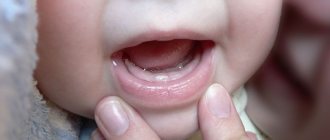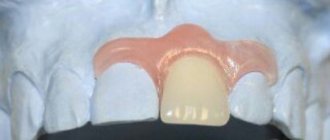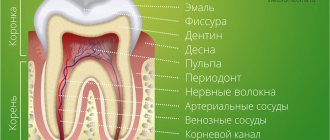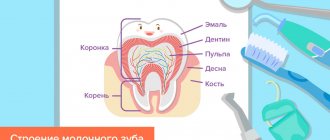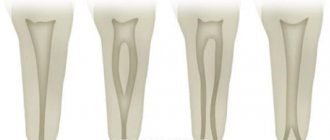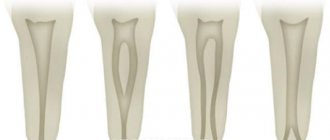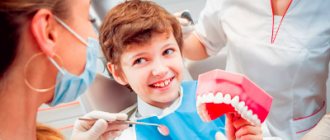Parents of every baby anxiously await the appearance of the first tooth. This event is celebrated as a holiday. They give gifts to the baby and invite guests. After the baby is born, in the first year of life, this is the first significant event, indicating that the development of the rudiments of teeth, which begins in the womb, at seven weeks of pregnancy, was normal, and the baby does not have terrible pathologies such as edentia . But at seven weeks, baby teeth begin to form. Permanent, radical rudiments also form when the child is still in the mother’s womb, at the 17th week of pregnancy. For some, the appearance of the first tooth occurs earlier, for others later. It depends on genetic characteristics and individual characteristics. But according to the dental norm, the baby’s first tooth should appear between 4 and 12 months. Shifting the timing beyond this period may indicate pathology and requires contacting a specialist for advice.
Anatomy of permanent teeth
Each molar consists of certain parts:
- crown. This is the part of the tooth that protrudes from the top;
- the root, it goes deep into the alveoli. At the same time, it is attached thanks to special connective tissue bundles. There can be different numbers of roots (1-5 pieces). This moment affects the number of nerves and channels;
- neck. This part is located between the root and the crown.
Tooth tissues are distinguished by their heterogeneity. The enamel is on top and is known for its durability. Once the tooth has erupted, it is covered with a transparent thin layer. This is the cuticle, which eventually changes to the pellicle. The latter is a film that is created from what saliva produces.
Beneath the enamel is dentin, the tissue of the tooth. Dentin is similar to bone when you study how it is built. However, it is more durable because there is a high level of mineralization. In the area where the root is located, the dental tissue is covered with cement. The latter is rich in mineral compounds and is also associated with periodontium. Collagen fibers are used for this.
As for the part of the tooth that is inside, this is the crown and root canal. They are filled with pulp. This is loose connective tissue; it contains nerve endings and blood vessels.
Injuries
An accident or incident, such as a fight, can cause a tooth injury. And it doesn’t matter whether a small part has broken off, or the tooth has cracked, as they say, “to the point of bleeding” - the help of a doctor is definitely needed. In some cases, lost dental tissue is replenished. If a tooth is broken into pieces, it will most likely need to be completely removed and a prosthesis replaced every year. And the answer is simple - the dental tissues have not yet fully matured, the body is growing. And it is necessary to take full care of your teeth at such an early age. In case of extension, the operation is performed by introducing composite materials that replace enamel and dentin.
Differences between baby teeth and permanent teeth
Permanent and temporary teeth are built in the same way, but still have certain differences between themselves:
- The enamel on baby teeth is whiter. And the enamel on permanent teeth has a yellowish tint;
- the best indicators of density and mineralization are noted behind the molars;
- the pulp of a baby tooth is large in size, and the dense tissues and their walls are thinner;
- permanent teeth are larger in size, here the length is greater than the width;
- The root of baby teeth is short and thin compared to permanent teeth. When the root of temporary teeth is formed, they expand in width. Therefore, the permanent bud has free space to grow.
Where do teeth come from?
Teeth begin to form and develop when the fetus is still inside the womb (at about 6 weeks). They have their source - the epithelial dental plate. Already by 14 weeks, active formation of dental tissues, which are hard, occurs. Initially, this occurs in the area where the crown will be, and later at the root.
Molars, namely their first rudiments, appear by the 5th month of the embryo. They are located higher than the child’s baby teeth or lower. By the time the child is born, the rudiments are already practically formed in the tissues of the jaw.
Teeth that belong to an additional group (have no predecessors) are formed later. This occurs after about 1 year of life. Why? Because the baby's jaw is still very small and there is not enough space for them.
Complications
During the period of growth of molars, it is necessary to pay attention to their even growth. Normally, if the permanent ones grow after temporary spaces are vacated in the dentition, and do not “prop up” them, as sometimes happens, they grow evenly and form a correct bite. But if there is an obstacle in the form of a milk tooth that has not yet fallen out, they can become curved and begin to grow incorrectly.
By the way. Crooked molars can be helped by a child's habit of thumb sucking, nail biting, or putting foreign objects into the mouth, such as chewing on the tip of a pencil.
If you notice irregularities in your bite, you should immediately contact an orthodontist to correct the growth of your teeth.
Adentia and retention - pathology or normal
When there are no teeth in the jaw at the end of its formation, this is a disease called adentia. Partial is diagnosed when several teeth are missing. If the teeth have not grown at all (a very rare anomaly caused by genetic disorders or abnormalities of intrauterine development), this is complete edentia. The disease is a pathology and requires orthopedic treatment (installation of prostheses).
Retention means a delay in eruption. The rudiments of teeth in the jaw are visible using x-rays; they are formed, but the tooth still does not want to grow. In this situation, which occurs almost consistently with the appearance of the upper canines and wisdom teeth, or the loss of a baby tooth too early, the adjacent permanent teeth close over the voids, leaving no room for the growth of retained molars.
What does a dental formula look like?
To make it more convenient to describe teeth and their number, special formulas are usually used. Each tooth has its own number, which is used to decipher its location.
When describing a milk bite, Roman numerals are used:
- incisors – I, II;
- canine – III;
- molars – IV, V.
If we talk about the formula for adult teeth, here the teeth are counted starting from the center:
- incisors – 1.2;
- fang – 3;
- molars (small) – 4.5;
- molars (large) – 6,7,8.
8 is a wisdom tooth; not every person has it.
Teething order
Typically, all children start teething at about the same time. Teeth emerge from the molar set at the age of 5, and it is the molars (large ones) that emerge. Then the diagram is as follows:
- Initially, the incisors on the lower jaw change, which are located in the center;
- then the central incisors appear on the upper jaw and the incisors on the sides on the lower jaw;
- at about 8-9 years old, the incisors on the top and sides change;
- up to 12 years of age, molars (small) grow;
- at the age of 13, the fangs change;
- after the child turns 14 years old, the second molars (large ones) come in. They were not included in the milk kit;
- and after another 1 year the third molars (large) appear. This is a wisdom tooth. But he may not appear at all.
Molars
The most important task of molars is chewing food. They do not appear at an early age, since there is no need for the chewing function yet.
But when they begin to erupt, it causes a lot of discomfort for children and worries for their parents. After all, the structure of the molar tooth is different from the rest.
The molars of the upper jaw have three roots and four internal canals, and the molars of the lower jaw have two roots and three canals. But the problem is not in the root canals, but in the fact that these are the largest teeth with a wide chewing lumpy surface, which is why the tooth erupts quite slowly, literally cutting through the gum.
The process almost always causes pain and inflammation of the gums. And if you consider that the first tooth without a future replacement is a molar six, which comes in at the age of about 5-6 years, then it is necessary to show due attention. In addition to its proper formation, it must be healthy. Indeed, in case of damage, for example, by caries, removal of the six tooth will entail further prosthetics or leave a void, which can also affect the formation of the jaw and the entire bite.
How to determine that a child will soon have molars?
There are certain signs that indicate that permanent teeth will soon begin to erupt:
- The spaces between the teeth increase. The jaw grows and the free space increases;
- baby teeth become loose as the root gradually dissolves. It cannot be firmly fixed in the jaw tissues;
- in case of loss of a temporary tooth. This confirms that the molar will soon come out as it has pushed out the previous one;
- The gums are slightly swollen and red.
When permanent teeth erupt, the child’s general well-being usually remains the same, the temperature does not rise, and there is no pain.
Content:
- Formation of permanent bite:
- Eruption of permanent teeth in children: timing and features:
- Features of care.
1.1. How does eruption occur?
2.1. Approximate timing of bite change. 2.2. Associated symptoms.
Until recently, dentists, like pediatricians, were quite strict about the time frame for the eruption of molars in children. In accordance with generally accepted standards, this process begins at 6 years and ends by 12–13 years. But as clinical data accumulates, experts are increasingly inclined to believe that such terms are quite arbitrary, that is, they are observed in most children, and deviations from the norm are not always a sign of a disease or some kind of developmental disorder.
Possible problems
Permanent teeth have just appeared, but this does not mean that there will not immediately be any problems associated with them. Parents should be aware of possible dental problems:
- lack of molars;
- pain in the molar area;
- crooked position of molars;
- molars fall out;
- injuries.
For any of these problems, it is important to contact a specialist in time to receive qualified help.
Indications and contraindications for removal
The absolute indication is acute purulent inflammation with the possibility of developing osteomyelitis or phlegmon.
Relative readings:
- development of a cyst at the root;
- destruction of the outer part of the tooth without the possibility of restoration;
- dystopia or incorrect position of the tooth in the gum;
- malocclusion;
- periodontitis of the third and fourth degrees;
- dental inflammation caused by tuberculosis or actinomycosis;
- supernumerary six teeth, upper or lower, which cause malocclusion;
- damage to the tooth root during dental surgery.
